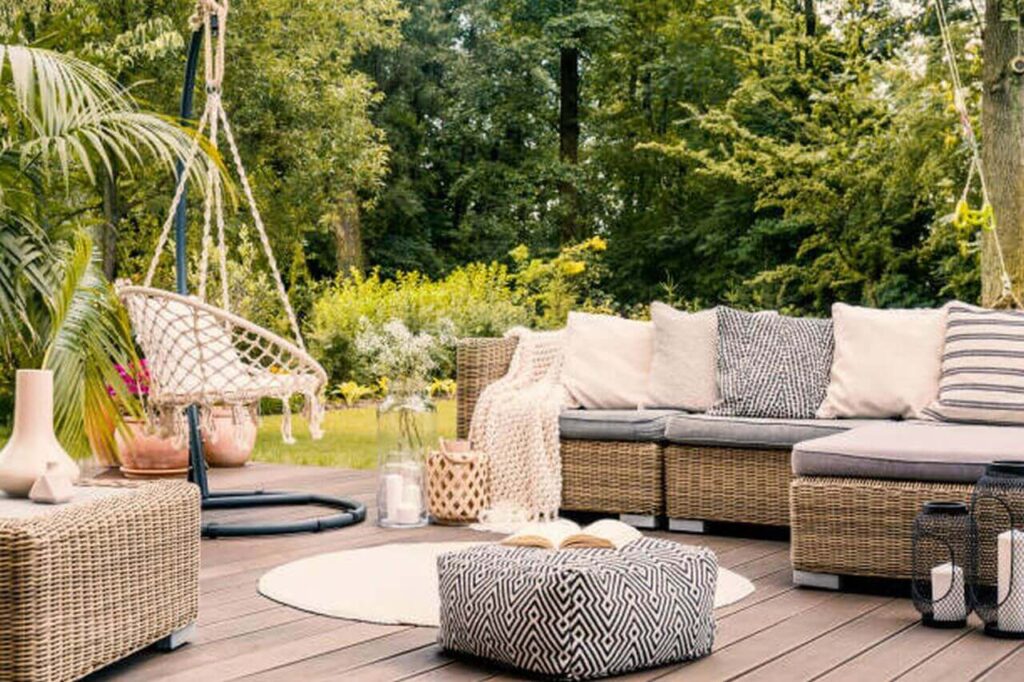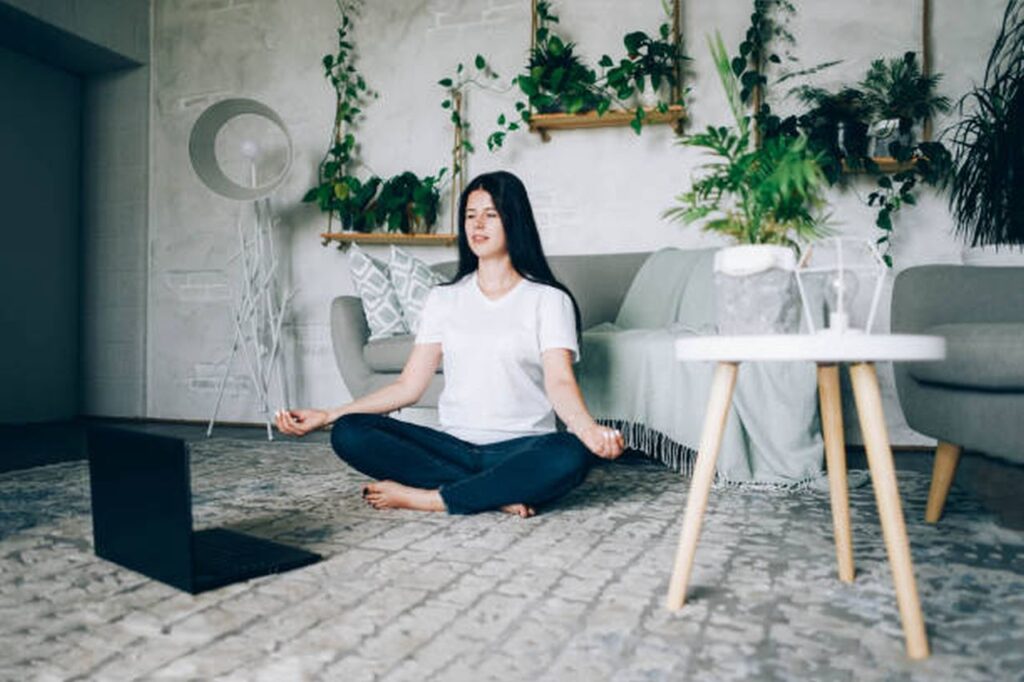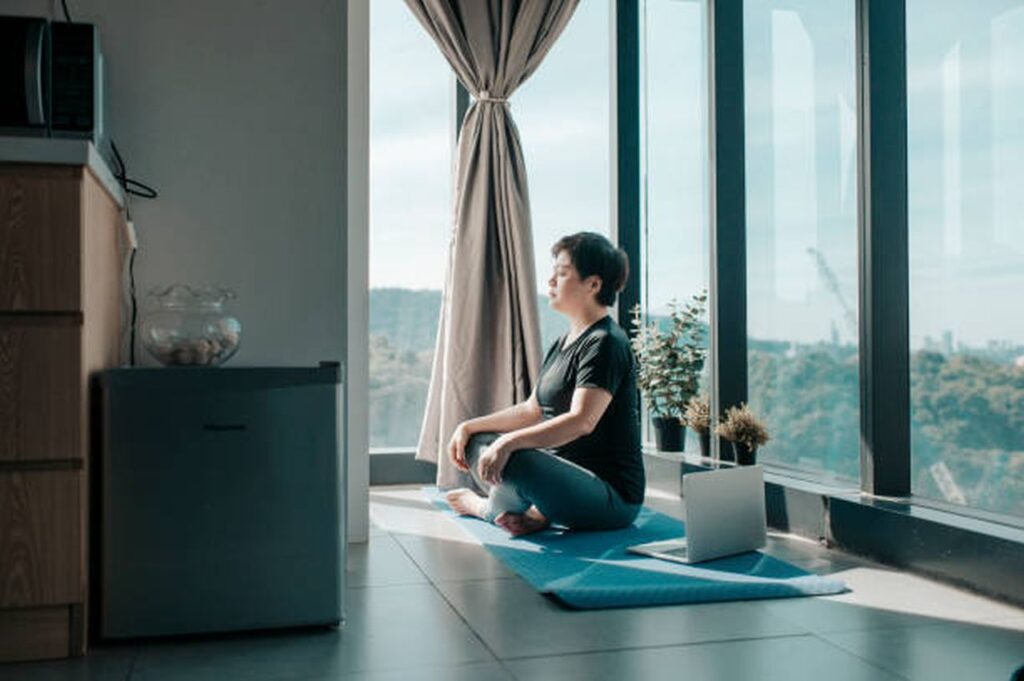A home should always be a place of calm, soothing feelings, an oasis in the middle of a hectic world. You surround yourself with objects you love, colours that make you feel blissful and family photos that bring back happy memories.
But what if you set aside a special corner or even a room of your home that you completely devoted to banishing stressful emotions? Meditation can be a great way to do just that, through focusing, breathing, and clearing your mind. In addition, your meditation practice can be improved by comforting surroundings and thoughtful design details, which you can achieve in your own home without going to a studio.
Embrace Minimal Décor
When it comes to a meditation space, often less is more, proven through this nook featured on interior stylist Jason Grant’s website. For your own space, incorporate simple cushions, a small stool, and a textured area rug, and you’re ready to meditate in a no-frills, yet chic, space.
Spotlight Your Personality
For a meditation space to feel good, it has to feel like you, right? So you can get truly comfortable when you’ve woven in pieces that have meaning to you, like a joyful Buddha statue, a warm throw blanket, and a colourful rug, which is what space and lifestyle design coach Kelly Anderson did here. She also inventively transformed a spot at the top of the stairs into a meditation corner, and she shares her tips in a blog post.
Choose Soft Colours
While bright, bold colours can be fun, there’s something about whispery, pastel hues that’s oh-so-soothing. Even though your eyes will likely be closed while you meditate, it’s important to feel comforted in the space as soon as you sit down.
Take Your Meditation Space Outdoors
It makes perfect sense to take a meditation practice outside, where you can soak up the sounds of the birds chirping and the wind blowing through the trees. You can design it however you like (be sure to include waterproof, outdoor-friendly pieces and materials), or you can go all-out for an afternoon of meditating with a space that’s outfitted with dreamy textiles, candles and vintage pieces, like this one created by Sian of Sian Loves.
Make It Light And Bright
It can feel good to have some sunlight on your skin and a breeze coming in through a window when you’re meditating. So when crafting your meditation corner, try to place it next to a window, which is what Alexandra of To Vogue or Bust did in her own home. She styled this corner using a faux fur rug, woven pouffe, a small ladder and meditation must-haves, like essential oil and a diffuser.
Mimic A Professional Studio
If you have a favourite studio where you like to meditate, you can borrow the design aspects of that studio and bring them into your space.
Bring Nature Into Your Space.
Studies show nature is soothing and healing, so bring some element of nature into your space. “I like to have something that embodies each of the four elements — earth, air, fire and water,” says Lena Franklin, a mindfulness-based psychotherapist and content creator for the Welzen app. “From an intentional perspective, it creates universal balance in the space. But including nature in your meditation space can be as simple as a plant or vase of cut flowers.”

Personalise Your Space
A shrine or altar isn’t necessary but set up a small table or landing place for meaningful items. “It can be a picture of your dog,” Franklin says. “You want the items you see to help you transition to a quiet, present mindset, ignite and touch the heart, and inspire you.”
Take It With You
Some aspects of your space will make it feel special and inviting. If you know, you’ll be away from home, consider taking some small piece of it. It could be a photograph, essential oil or sacred book. By having something familiar in your temporary space, your mind and body will easily settle into the experience, even when you’re away from home.
Create Your Mindful Corner.
Brent is all about creating ceremonies at home, so it’s important to create a special corner or even a room at home to practice daily meditation. This space allows you to recharge both physically and mentally and keep you balanced.
You do not need an entire room for it—an empty corner, a space in your closet, bathroom, living room, or even a spot in your backyard or garden will work just fine. Instead, you need to set aside a special place completely devoted to being still and working out your mind. It’s less about space and more about picking out and prioritising an area where you can focus on yourself—even if it’s just five minutes a day.
Make It Comfortable
When creating your personal meditation space, Brent tells me there are three essential elements: Texture, scent, and lighting. “Touching on these three senses can make even the smallest spaces feel serene,” he says. The space should also be comfortable and calming yet in sync with the rest of your home.
Consider loading up on rugs, throws, meditation cushions, or floor pillows to transform your corner into a cosy meditation oasis. We love layering sheepskins on top of rugs and using large pillows to deck out the space. Or, if you have the budget, consider investing in a few meditation cushions—they are designed to help alleviate pressure on certain parts of the body, as I know it can be challenging to stay present if your leg is falling asleep or your back starts to hurt.
We also love using sound baths (if you don’t want to buy your own, there are lots of good bath playlists online you can play instead), Himalayan salt lamps, and candles are another great, easy way to set a comfy, serene vibe in your space. Infusing these elements will go a long way in creating zen feelings and help improve your practice.
Pick Somewhere That Has Natural Light.
Natural light is huge in helping me feel awake, grounded, and focused—you see it everywhere in Brent’s home. Choose an area in your home for your personal meditation space with a window or skylight that allows natural light to flow into your space. If you live in a small apartment or have minimal windows, consider rethinking certain rooms or areas in your home to accommodate—can you sacrifice some space in your WFH area, dining area, or living room to devote to your meditation space? Get creative in choosing the perfect corner—remember, this is a space that you will (hopefully) be using every day. Rethinking areas that you may not use as much as you had originally thought maybe the best option for creating your perfect meditation space at home.
Could You Keep It Clean And Uncluttered?
When it comes to a meditation space, often less is more. You want this space to feel light, bright, and clean. And, having clutter around you will most likely have you feeling more cluttered in your mind. Try to choose an area with distractions like the TV or your computer out of sight. Remember, the whole point of meditation is to remove stress from your life, so don’t create extra stress by trying to perfect over-the-top meditation space. You want a minimal, no-frills, quiet, and relaxing space that instantly makes you feel calm when you step into it.
You can choose any natural elements you like or any nature that brings you joy—this can be a potted plant, a vase of cut flowers, decorative branches, a small succulent garden, jars filled with sand or seashells, or even a small electric water fountain that trickles in the corner if you have space—(talk about zen vibes!) If you’re trying to keep things compact, built-in shelving is ideal for displaying lots of little green things without encroaching on valuable real estate in your space.
Add A Personal Touch.
When creating your mediation space, you want to include some of your personal touches. Brent is big on infusing sentimentality. Every inch of their home is layered in meaning. It can be anything from a smell, sound, or object that soothes your mind and relaxes it. Think of incorporating things like a diffuser with essential oils, candles, bells, chimes, crystals, a statue of Buddha, mala beads, words of affirmation, or artwork. Adding any of these to your space are great ways to create a serene and peaceful environment that feels unique to you and allows you to get excited and focused on meditating.
Remember, however, that you do not want to overcrowd the space. A clean and clear environment needs to keep your mind open. Choose only a few pieces at a time, and swap them out for different ones now and again if you cannot decide. This personal experience is meant to inspire you to connect with yourself, so have some fun with it!
Find A Calm Space
Choose a silent space within your home that is free from distractions and has a limited traffic flow. For example, you can create a meditative corner within your bedroom living room or even use a small area in your backyard, balcony, garden or terrace.
Introduce Comfortable Seating
Avoid sitting directly on the floor and meditating. Instead, use a soft yoga mat, a meditation cushion, a small carpet for the asana, or choose a low height mattress with soft cushions as a backrest. If you have difficulty sitting on the floor, opt for a comfortable stool or chair with a good backrest.
Use A Soft Colour Scheme
Bring in an element of calm and serenity within your meditative corner with a soothing colour scheme. Go for neutral tones like white, beige or pastels for the walls, curtains, wallpaper, cushions and seating. Avoid using bold patterns and busy, distracting prints.
Include Meditative Tools
Practice meditation with meditative tools like a singing bowl, the sacred mala, bells, chimes, crystals, affirmation stones, etc.
Keep It Minimal
Although there will be other furniture within the room, make sure your meditation space is clean and empty. Note that a neat and clutter-free space helps the mind to remain calm and stay focused.
Accessorise
You can introduce accessories like a Buddha painting, Buddha statue, pink Himalayan salt lamps and candles as they release a peaceful aura within the meditation space. Choose materials like stone, terracotta, and weathered wood resistant to external weather elements for the outdoors.
Bring In Natural Light
The meditation corner should be well ventilated and near a window to bring maximum natural light and breeze. Additionally, use sheer curtains for the windows that allow sunlight to pass through. If you plan to meditate in the evening, then light up the space with dim or bright lights as per your preference.
Introduce Plants
Add touches of nature by introducing plants as they impart a rich meditation experience. For example, purchase a lucky bamboo plant or opt for air-purifying plants like the spider plant (Chlorophytum comosum), peace lily (Spathiphyllum wallisii), Boston fern (Nephrolepis exaltata), English ivy (Hedera helix) and areca palm (Dypsis lutescens).

Introduce Fragrance
If you want your meditative space to smell nice, use aromatic incense sticks or lightly-scented candles while meditating. You can also keep potpourri in a decorative bowl or install a diffuser with essential oils like lavender, eucalyptus, rose and sandalwood, to name a few.
Fill The Room With Soothing Music
The mind can easily achieve a tranquil and peaceful state with light meditative music. So, make sure that the meditative area has an electrical plug point and side table for installing an audio sound system. Alternatively, you can introduce an indoor water fountain as it produces a soothing sound and creates a blissful meditative experience.
Choose A Feel-Good Space.
You want to pick a room in your home that makes you feel good. It means a room that makes you smile when you walk into it. In addition, you want it to be a quiet room in the house and a room with a limited amount of traffic.
When choosing the room, pay attention to the lighting as well. For instance, a room with a lot of natural light will instantly enhance your mood. You might want to choose a room that faces the sun for the time of day you plan to meditate. Or better yet, a room that has a sunset view—now that would be a gorgeous way to begin meditation!
Consider outdoor space if you cannot find a ‘room’ that possesses these qualities. It is maybe your patio, deck, or even your floral garden. In addition, you want a place that allows you to relax your mind and body without being distracting.
Why Create A Meditation Space?
When we walk past our desk, we may be reminded to pay bills. When we walk past the refrigerator, we may be reminded to take something out for dinner. A meditation space reminds us of our intention to practice stillness.
You don’t have to believe in Feng Shui to know that our surroundings powerfully influence us. For example, if we use our bedroom for noisy activities during the day like watching TV or working out, we may find it difficult to rest in that same space in the evening. Similarly, we might have trouble with our mindfulness practice if we try to cultivate stillness in an area of our home associated with activity and energy.
Conclusion
So, there you have it! Everything you need to know about creating your meditation corner at home. By following these simple tips, you can create a perfect space for relaxation and reflection. We hope that this has been helpful, and we encourage you to give meditation a try. If you’re looking for more information or want some guidance on how to get started, be sure to check out our other posts on meditation or contact us for personal coaching. Thanks for reading!
FAQs
What Do You Put In A Meditation Corner?
Think of items such as bells, chimes, crystals, affirmation stones, beads, and artwork. These are great elements for creating a serene and peaceful environment for you to focus solely on meditating. Remember, however, that you do not want to overcrowd the space.
How Do You Decorate A Meditation Corner?
Use a Soft Colour Scheme. Bring in an element of calm and serenity within your meditative corner with a soothing colour scheme. Go for neutral tones like white, beige or pastels for the walls, curtains, wallpaper, cushions and seating. Avoid using bold patterns and busy prints, which are distracting.
Can I Meditate In My Bedroom?
It is ok to meditate in bed (or any other comfortable place), where you can feel relaxed and have positive, peaceful and quiet moments to focus on yourself. Hartwig W. To meditate at bedtime, you could meditate anywhere you want. It helps to get relaxed, calmed and focused.
What Colour Should A Meditation Room Be?
When designing a meditation space, some of the most popular earth-tone colours include Neutrals: Beige, Eggshell, Light Brown, Dark Browns. Grey: A variety of grey shades work with a wide range of accent colours. Colours: Rust orange, Hunter green, Navy blue, Cerulean blue, Eggplant, Berry, Blush.
What Colours Are Considered Zen?
One hallmark of traditional zen spaces is that they tend to be dominated by neutral and earthy colours, especially beige and browns. More contemporary zen styles may veer towards white and black colour schemes. However, since zen is all about relaxation, the soothing tones of neutral colours typically dominate.

